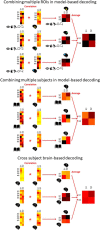An Integrated Neural Decoder of Linguistic and Experiential Meaning
- PMID: 31570538
- PMCID: PMC6832686
- DOI: 10.1523/JNEUROSCI.2575-18.2019
An Integrated Neural Decoder of Linguistic and Experiential Meaning
Abstract
The brain is thought to combine linguistic knowledge of words and nonlinguistic knowledge of their referents to encode sentence meaning. However, functional neuroimaging studies aiming at decoding language meaning from neural activity have mostly relied on distributional models of word semantics, which are based on patterns of word co-occurrence in text corpora. Here, we present initial evidence that modeling nonlinguistic "experiential" knowledge contributes to decoding neural representations of sentence meaning. We model attributes of peoples' sensory, motor, social, emotional, and cognitive experiences with words using behavioral ratings. We demonstrate that fMRI activation elicited in sentence reading is more accurately decoded when this experiential attribute model is integrated with a text-based model than when either model is applied in isolation (participants were 5 males and 9 females). Our decoding approach exploits a representation-similarity-based framework, which benefits from being parameter free, while performing at accuracy levels comparable with those from parameter fitting approaches, such as ridge regression. We find that the text-based model contributes particularly to the decoding of sentences containing linguistically oriented "abstract" words and reveal tentative evidence that the experiential model improves decoding of more concrete sentences. Finally, we introduce a cross-participant decoding method to estimate an upper bound on model-based decoding accuracy. We demonstrate that a substantial fraction of neural signal remains unexplained, and leverage this gap to pinpoint characteristics of weakly decoded sentences and hence identify model weaknesses to guide future model development.SIGNIFICANCE STATEMENT Language gives humans the unique ability to communicate about historical events, theoretical concepts, and fiction. Although words are learned through language and defined by their relations to other words in dictionaries, our understanding of word meaning presumably draws heavily on our nonlinguistic sensory, motor, interoceptive, and emotional experiences with words and their referents. Behavioral experiments lend support to the intuition that word meaning integrates aspects of linguistic and nonlinguistic "experiential" knowledge. However, behavioral measures do not provide a window on how meaning is represented in the brain and tend to necessitate artificial experimental paradigms. We present a model-based approach that reveals early evidence that experiential and linguistically acquired knowledge can be detected in brain activity elicited in reading natural sentences.
Keywords: concepts; fMRI; lexical semantics; multivoxel pattern analysis; semantic model; sentence comprehension.
Copyright © 2019 the authors.
Figures











References
-
- Abnar S, Ahmed R, Mijnheer M, Zuidema W (2018) Experiential, distributional and dependency-based word embeddings have complementary roles in decoding brain activity. Proceedings of the 8th Workshop on Cognitive Modeling and Computational Linguistics (CMCL 2018), pp 57–66. Salt Lake City: Association for Computational Linguistics.
-
- Anderson AJ, Bruni E, Bordignon U, Poesio M, Baroni M (2013) Of words, eyes and brains: correlating image-based distributional semantic models with neural representations of concepts. Proceedings of the Conference on Empirical Methods in Natural Language Processing (EMNLP 2013), pp 1960–1970. Seattle: Association for Computational Linguistics.
Publication types
MeSH terms
LinkOut - more resources
Full Text Sources
Miscellaneous
